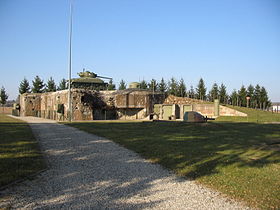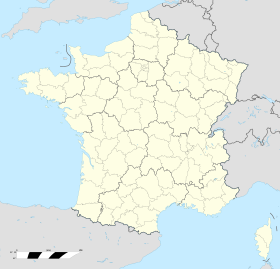Casemate d'Esch
| Casemate d'Esch | |
|---|---|
| Part of Fortified Sector of Haguenau, Maginot Line | |
| Northeast France | |
 |
|
| Coordinates | 48°53′35″N 7°33′21″E / 48.89295°N 7.55589°E |
| Site information | |
| Controlled by | France |
| Open to the public |
Yes |
| Condition | Preserved |
| Site history | |
| Built | 1931 |
| Built by | CORF |
| Materials | Concrete, steel |
| Battles/wars | Battle of France, Operation Nordwind |
The Casemate d'Esch is a pre-World War II fortified position near the German frontier in extreme northeastern France. Built in 1931, the casemate was part of an extension of the Maginot Line fortifications along France's border with Germany. As a unit of the Fortified Sector of Haguenau, the casemate was part of French defenses during the Battle of France, but saw no combat in 1940. The area was the scene of intense fighting between German and American forces in 1945. The casemate with the marks of the 1945 combat has been preserved and is part of a museum associated with the nearby Ouvrage Schoenenbourg. The museum is located at the southeastern edge of the town of Hatten.
Esch was built in 1931 by the Commission d'Organisation des Régions Fortifiées (CORF), which was responsible for the major fortifications of the Maginot Line. Esch was one of the first of a series of casemates extending east from the last major position in the Maginot Line, Ouvrage Schoenenbourg. Cost was about 1.06 million francs of the time. The casemate line formed a barrier across the Alsace Plain between the Vosges Mountains, whose last outlier was at Schoenenbourg, and the Rhine River.
The Esch casemate is a double casemate on one level, designed to fire laterally in either direction along the front, supporting its neighbors to the east and west. The position was armed with two twin heavy machine guns, type JM and, two 47mm anti-tank gun/JM combinations, one of each firing laterally. These embrasures were covered by automatic rifle ports firing across their fronts. A projecting caponier defended the entrance with automatic rifle fire, with an additional firing port to the north. On top of the fort, two GFM cupolas or cloches armed with automatic rifles were situated to fire in all directions. The casemate measures approximately 28 metres (92 ft) by 18 metres (59 ft), and is 7.5 metres (25 ft) high. Concrete thickness varied from 2.5 metres (8.2 ft) at the front to 1-metre (3.3 ft) at the rear. The casemate occupies a small hill, presenting an earth embankment studded with anti-tank rails to the north. Its name is derived from the name of the locale in the Alsatian dialect, signifying a farmer's harrow.
...
Wikipedia

